German Schnitzel (Schweineschnitzel)
This post may contain affiliate links. See my disclosure policy.
This traditional German Schnitzel recipe, known as Schweineschnitzel, is just the way you know and love it from your favorite German restaurants! Made the way I learned it from my Mutti and Oma, this tutorial includes all the tips and tricks are included for making the absolute PERFECT Schnitzel!
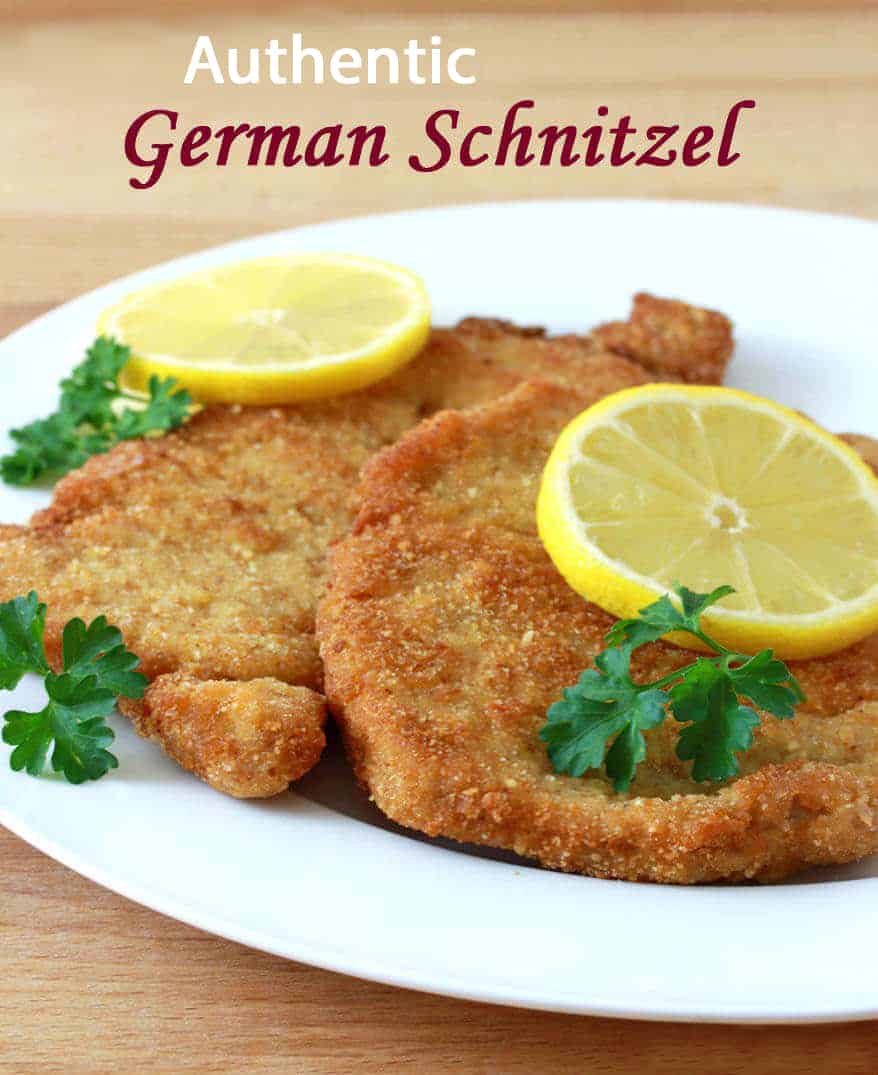
Being from Germany and as much as I love to cook, it would be unforgivably inexcusable, a total outrage, if I didn’t know how to make Schnitzel! After all, it’s one of the most quintessential German dishes. Practically every tourist to Germany has had Schnitzel and most fall in love with it.
Schnitzel vs. Wienerschnitzel: What’s the Difference?
Many people associate Schnitzel with Wienerschnitzel. However, “Wienerschnitzel” is actually a geographically protected term in Germany and Austria and can only be made with veal. German Schnitzel is prepared the same way as Austrian Wienerschnitzel, but the difference is that German Schnitzel, known as Schweineschnitzel, is made with pork instead of veal. As for where the Schnitzel originally came from…the technique of breading and frying thin cuts of meat is attributed to the Romans from around 1 BC. Another factual tidbit: Austrians will be the first to admit that Wienerschnitzel doesn’t come from Wien (Vienna).
But whether it’s Schweineschnitzel or Wienerschnitzel, when it’s perfectly breaded, perfectly fried, and perfectly crispy, practically everyone loves a good Schnitzel! And now you can make it – perfectly – in your own kitchen!
Variations
The most popular variations of Schnitzel are Jägerschnitzel (“hunter schnitzel”) which is served with mushroom gravy, Zigeunerschnitzel (“gypsy schnitzel”), served with a zesty bell pepper sauce, and Rahmschnitzel (“cream schnitzel”) served with a delicious creamy Rahm Sauce. All three are commonly found in German restaurants and are all positively delicious. If you love Schnitzel you have to try them all!
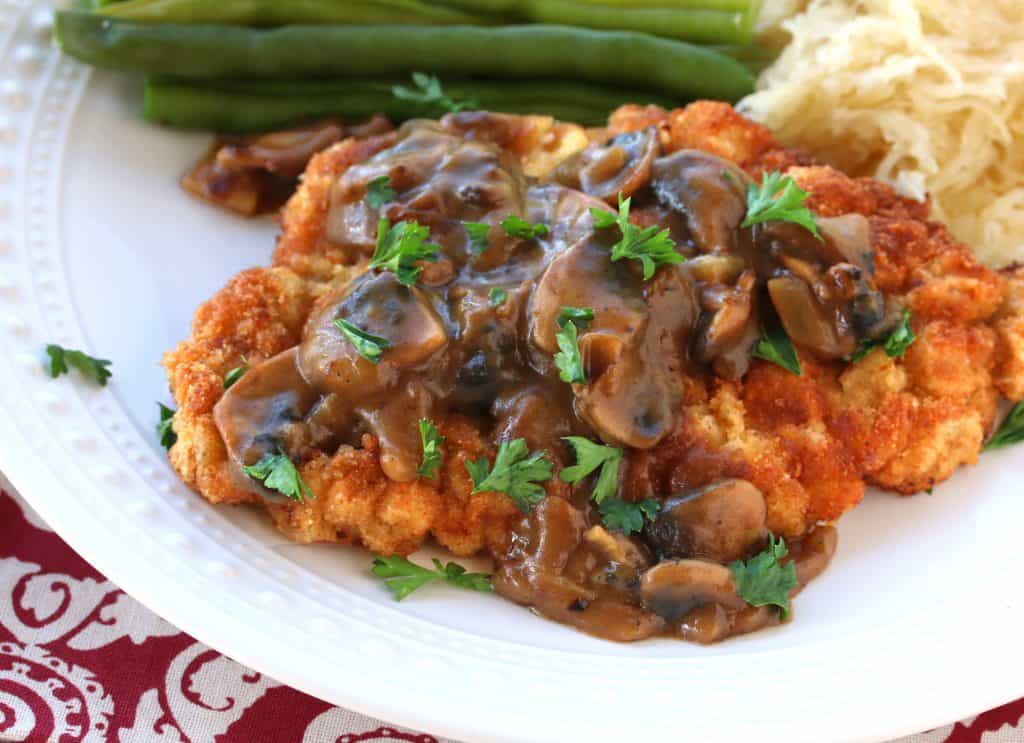
Schnitzel Recipe
Let’s get started!
Throughout the pictured recipe steps below, I’m going to share some tips and tricks with you that are important for achieving perfect results – just like the kind you get at a German restaurant.
Pro Tip 1: Pound the meat very thin, no more than 1/4 inch thick. The reason this is important is because you’ll need to fry it at high heat for a short period of time to get that perfect crispy crust without leaving the middle of the meat raw.
The easiest way to pound the pork is to lay it between two pieces of plastic wrap. Be sure to pound them using the flat side of a meat mallet. Lightly sprinkle each side with salt and pepper. Dip the pork into the flour, coating all sides.
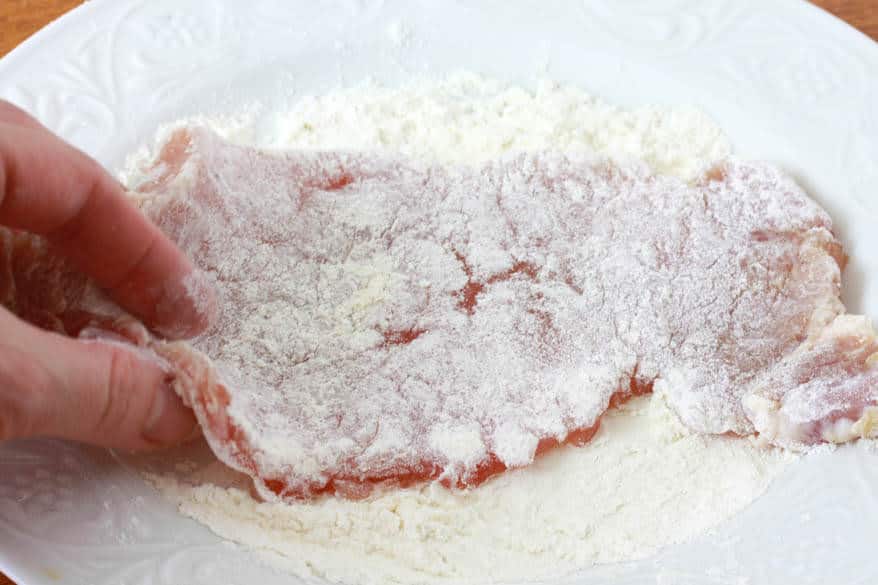
Next dip the pork into the egg mixture, coating all sides.
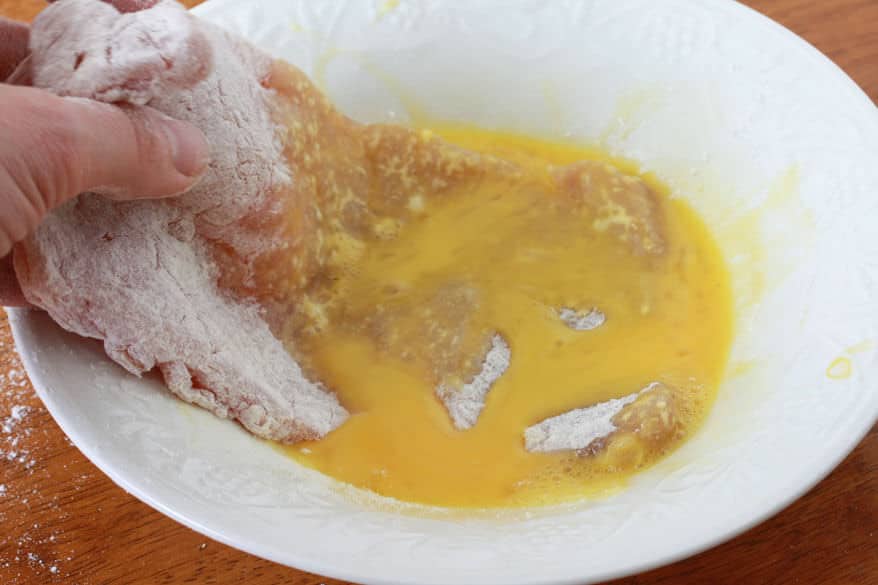
Then coat the pork with the breadcrumbs.
Pro Tip 2: Don’t press the breadcrumbs into the meat. Just softly coat the pork on both sides and all edges, and then gently shake off any excess.
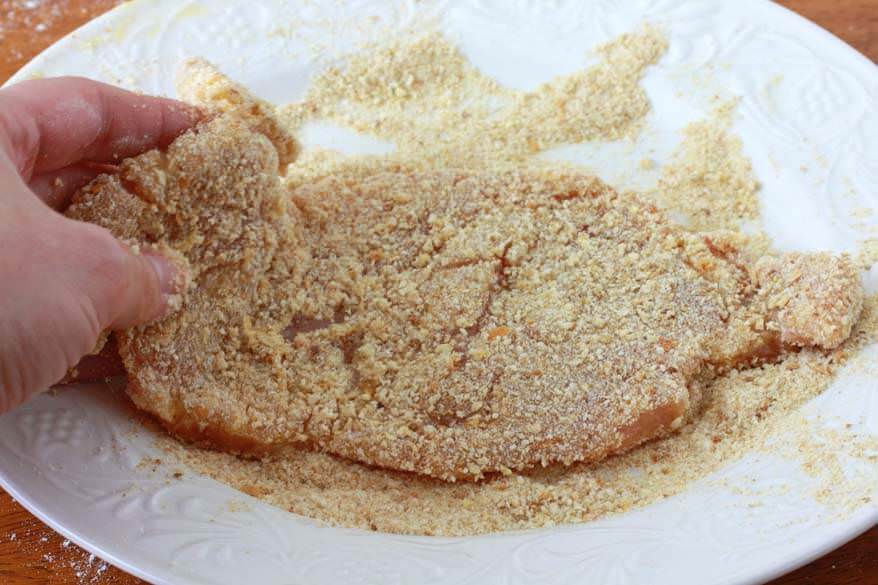
Pro Tip 3: Fry the Schnitzel immediately. Don’t let them sit in coating or the end result won’t be as crispy. You don’t need a ton of oil, but you need enough so that the Schnitzel can “swim”.
Pro Tip 4: Make sure the oil is hot enough – but not too hot. It should be around 330ºF – test it with a candy thermometer. If it’s too hot, the crust will burn before the meat is done. If it isn’t hot enough, you’ll end up with a soggy coating. When the oil is hot enough it will actually penetrate the coating less and you’ll end up with a crispy “dry” coating instead of an overly oily one. The result will be a beautifully crispy coating with a tender and juicy interior, and that’s exactly what we want.
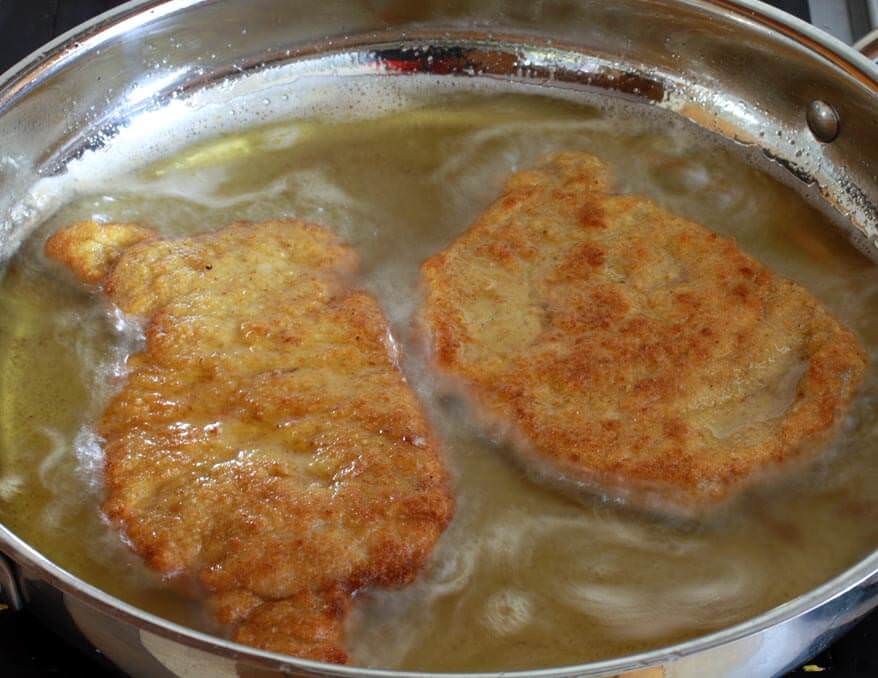
Remove the Schnitzel from the fry pan and place them briefly on a plate lined with paper towels. Transfer them to serving plates and garnish with slices of lemon and fresh parsley sprigs.
Serve immediately with French fries, Spätzle, or German potato salad and a fresh leafy green salad. See blog post below for more serving recommendations.
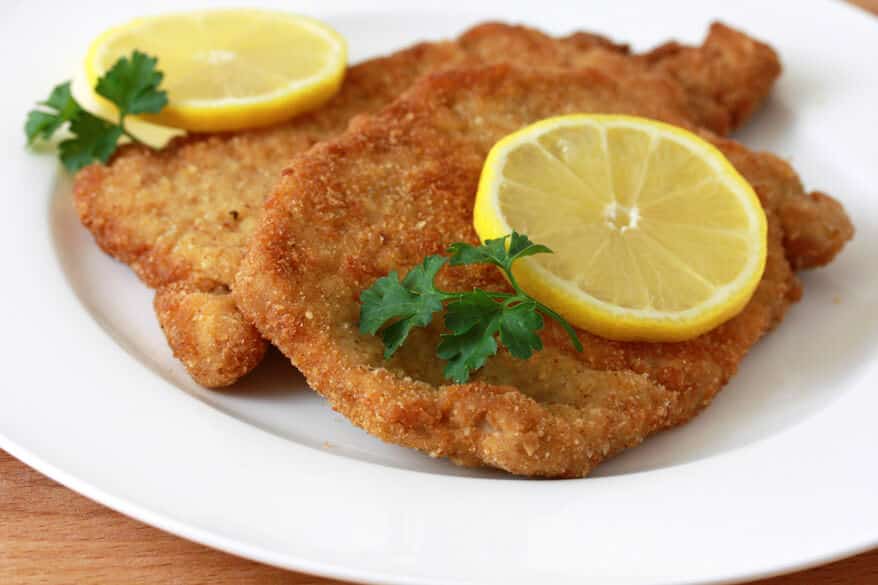
What to Serve with Schnitzel
In Germany, Schnitzel is commonly served with any of the following:
- Pommes (French fries); see my Oven Baked French Fries or Baked Potato Wedges.
- Spaetzle and gravy
- German Potato Salad
- Creamy German Cucumber Salad
- Krautsalat
- A leafy green salad
Additional serving options include mashed or roasted potatoes, Sauerkraut, Rotkohl, and roasted or steamed veggies. And if you want to pair it with some non-German sides you can serve it with classics like Creamy Coleslaw, Macaroni Salad, Classic Potato Salad, Baked Potato Wedges, Baked Beans, or Broccoli Salad.
Enjoy!
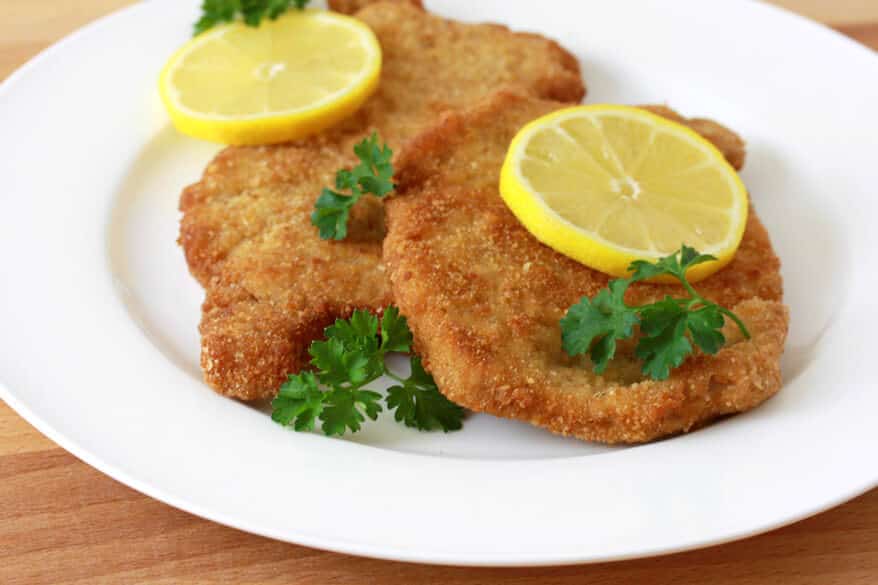
For more authentic German recipes be sure to try my:
- Sauerbraten
- Rouladen
- Schweinshaxe
- Königsberger Klopse
- Currywurst
- Käsespätzle
- Kartoffelpuffer
- Senfbraten
- Jägerschnitzel
- Maultaschen
- German Potato Soup
- Frikadellen
- German Sauerkraut Soup
Save This Recipe
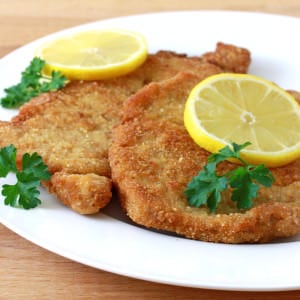
Traditional German Schnitzel (Schweineschnitzel)
Ingredients
- 4 boneless pork steaks or chops, (to make Austrian Wienerschnitzel use thin veal cutlets)
- salt and freshly ground black pepper
- 1/2 cup all-purpose flour combined with 1 teaspoon salt
- 2 large eggs, lightly beaten
- 3/4 cup plain breadcrumbs
- Oil for frying (use a neutral-tasting oil with a high smoke point)
Instructions
- Place the pork chops between two sheets of plastic wrap and pound them until just 1/4 inch thick with the flat side of a meat tenderizer. Lightly season both sides with salt and freshly ground black pepper.
- Place the flour mixture, egg, and breadcrumbs in 3 separate shallow bowls. Dip the chops in the flour, the egg, and the breadcrumbs, coating both sides and all edges at each stage. Be careful not to press the breadcrumbs into the meat. Gently shake off the excess crumbs. Don't let the schnitzel sit in the coating or they will not be as crispy once fried – fry immediately.Make sure the cooking oil is hot enough at this point (about 330 degrees F) as you don't want the Schnitzel to sit around in the coating before frying. Use enough oil so that the Schnitzels "swim" in it.Fry the Schnitzel for about 2-3 minutes on both sides until a deep golden brown. Transfer briefly to a plate lined with paper towels.
- Serve immediately with slices of fresh lemon and parsley sprigs. Serve with French fries, Spätzle or German potato salad, and a fresh leafy green salad.
Video
Nutrition
Originally published on The Daring Gourmet March 12, 2014

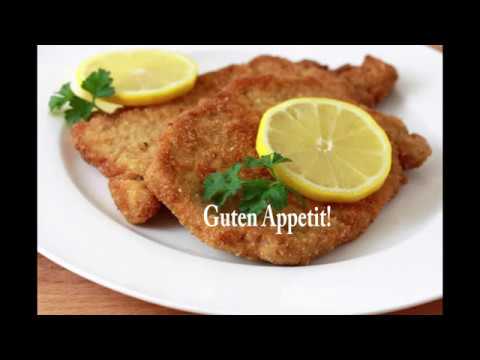

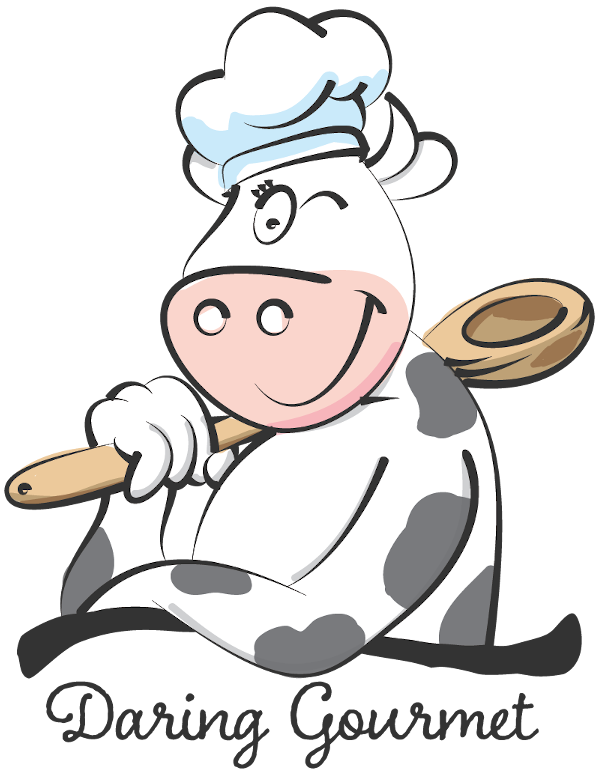
















This looks super good, can’t wait to make it!! My Oma has made this a couple times and its delicious!! I have a question for you though, I’m making this for my Adv. Culinary family meal project and I’m not sure what to make as a side dish. For one I’m making German potato salad but I’m drawing a blank for the second. Can you help me any?
Hi Karic! Most typically in German restaurants this would be served with French fries and a leafy green salad. German potato salad is great option, too, and you could still include the green salad with it. Happy cooking!
Alright thank you!!!
Vielen Dank! Just made it! Sehr gut!!! I have friends in different parts of Deutschland (have been there 7 times and love it and I’m obsessed with their food..Currywurst, Schnitzel, etc and Turkish Döner! ) I recently made Semmelknödel. It was much easier than I thought and if I can make it anyone can LOL Thanks again!! Mach’s Gut–Dave :-)
Fantastic, I’m so happy to hear it was a hit, Dave! I know, I really can’t get enough of German food either. And yes, the Döner’s in Germany are the BEST!! Thanks so much for your feedback!
Mmm Lecker Lecker! I’m making some for Mittagessen! Danke!!
That’s my kind of Mittagessen, Dave! Happy cooking!
Made this Schnitzel today and it was AMAZING. Reminded me of the kind I would have while living in Sachsen. Thanks so much for the recipe. It made us very happy!
I’m thrilled to hear that, Eric! Sachsen is a beautiful part of Germany and that’s wonderful that you had the opportunity to live there. Thanks so much for the feedback!
Hi! I am from sunny South Africa. I am so happy that I found your site. I made your schnitzel last night with our traditional pap and my family loved it. Next time I,ll make it with your food, I,ll let you know. Thank you.
Greetings to South Africa! I’m thrilled you found my site and am happy you enjoyed the first recipe you tried. I really appreciate the feedback, thanks so much!
I’m really surprised that they say it’s mainly made with pork when we lived in Germany for two years 1969 and 1970s it was always veal.
I would imagine it’s largely because of the stigma around veal and how the cows are handled, though fortunately those practices have been changing for the better. You can still find veal Schnitzel in Germany, but pork is much more common.
my Nan who was from switzerland used to cook this for us, mainly with pork but if she could get veal she would use that.
Was always pork when I was there in late 80’s and 90’s. I was in the Hunsruck area.
Hi Tom! Yes, it’s almost always pork, occasionally you can find veal.
Spent 3 years at Hahn Airbase. Schnitzel was always pork.
Hey Rick I was at Hahn!!! Small world….we are celebrating this Christmas dinner with German dishes!
Same here, I was there in the early 70’s and it was veal and delicious !
That is a completely different recipe, and it is not German it is Italian. Veal Saltimbocca with sage leaves. Cooked kinda the same way, but completely different recipe.
Original “Wiener Schnitzel” is made by veal, but in most restaurants you get it “Wiener Art” (“like” Wiener Schnitzel). Its pork then, just because its cheaper than veal.
German people love their pork! But Wienerschnitzel is a culturally protected dish and HAS to be made with veal. So whenever you eat it in a restaurant it will always be veal. But since us German’s love our pork, we always make all other variations of Schnitzel as well as the “without gravy” schnitzel, which what Wiener Schnitzel” is, with pork.
I hope that helps. P.S. I am 100% German, lived there from 1966-1987 and all my family is still there.
Made this for lunch today and it was delicious! Thanks for the great recipe!
Wonderful! I’m so glad to hear that, Natasha, thanks for the feedback!
This does look great but Schnitzel is Austrian not German.
Hi! It actually isn’t either Austrian or German, it’s Roman. But Austria is traditionally associated with Wienerschnitzel, which is strictly veal, not pork. And Austrians will even tell you that it did not originate in Wien (Vienna). If you read the post you’ll find the explanation.